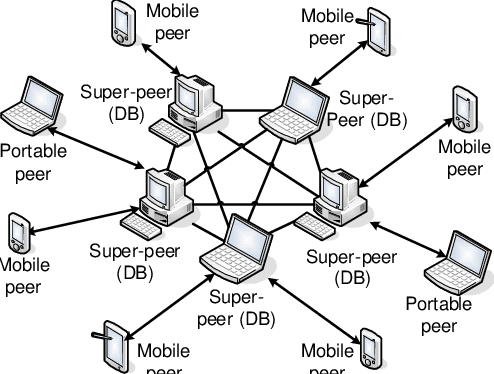The Blockchain comprises a set of peers that are connected with each other.
They serve as fundamental elements of the network for hosting ledgers and small contracts. The role played by peer-to-peer technology in Blockchain is highly remarkable.
It is very much helpful for the execution of trade-related activities without depending on intermediaries.
What is a Peer-to-Peer Network?
A peer-to-peer or P2P network comprises a wide range of devices that are arranged in a group. The systems collectively enable easy storing and sharing of files.
Every node is inclusive of equal power and performs the same action. Miners can add blocks to this blockchain network.
Such a great facility enables easy execution of trades without the help of any third party.
With an increase in popularity in 1990, today P2P network has become the core of Bitcoin technology.
It has also helped in leveraging distributed computing applications that include search engines, online marketplaces, and IPFS protocol.
There are certain cases where the P2P environment helps in an easy connection among lenders and borrowers.
The Working of the P2P Network
A P2P system is operated and maintained by a wide network of distributed users.
As every node is inclusive of a single copy of files, it hardly requires any central administrator.
Each node can download and upload the files, and all the transactions made with Bitcoin are stored in a public ledger. This is the main difference between a P2P network and a traditional server.
Software applications help in mediating easy sharing of the data.
As a user, you will be able to access other devices on the network for coming across the desired file.
On the other hand, the node serves as a client and downloads files from the nearby nodes of networks. Such an exclusive facility makes P2P technology a faster and efficient choice.
The distributed architecture makes it safe from cyber-attacks. This network does not comprise any point of failure. The peer-to-peer system has been categorized as per architecture.
The main ones include the following:
- Structured P2P network – A structured P2P network is known for presenting an organized structure so that the nodes can efficiently search the files. It tends to present a high level of centralization and requires high cost for maintenance.
- Unstructured P2P network –As clear from the name, an unstructured P2P network hardly presents an exclusive type of organization of nodes. Here, the participants communicate randomly with each other. As the queries related to search are sent out to highest numbers of peers, this network requires high usage of memory and CPU.
- Hybrid P2P network –The hybrid P2P network combines the client-server model with the aspects of P2P architecture. It results in the designing of a central served that facilitates an easy connection between peers.
After coming across the various types of P2P network models, it is high time to know about the role of peer-to-peer technology in Blockchain.
Role of Peer-to-Peer Technology in Blockchain
Peer-to-peer technology is totally based on the concept of decentralization. The P2P architecture of Blockchain permits almost every cryptocurrency to get money transferred all over the globe.
There is no need for any middleman at the time of carrying out any transaction.
You can make a payment without going through your bank page and you can make your payment and buy Bitcoin without with anonymous identity. It means, no government or agency can track your payment and online transactions.
Related: Reasons Why Bitcoin Is So Popular?
Pros and Cons Related to P2P Technology
Peer-to-peer technology plays a vital role in the Blockchain. The advantages associated are innumerable. Some of the highly remarkable ones include the following:
- It is easily available due to decentralization
- Other peers will be in an active state even if one peer gets down
- High level of security ensured than traditional client-server system
- No risk of getting the crucial data modified
Apart from the exclusive benefits associated, there are some shortcomings that are expected to repair in the future. They include:
- The peer-to-peer network is virtually immune to online attacks
- Addition of transaction records requires a high amount of computational power
- Sometimes the efficiency gets reduced that results in a hindrance in terms of scalability
It is expected that these cons will get addressed in the future.
High technical advancement will help in making Blockchain a reliable technology for carrying out trade-related activities.
If you want to buy Bitcoin then you can simply use bitcoin investing.
It is a trusted app used by many investors.










